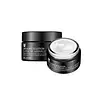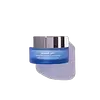What's inside
What's inside
 Key Ingredients
Key Ingredients

 Benefits
Benefits

 Concerns
Concerns

 Ingredients Side-by-side
Ingredients Side-by-side

Water
Skin ConditioningGlycerin
HumectantButylene Glycol
HumectantCyclopentasiloxane
EmollientButyrospermum Parkii Butter
Skin ConditioningOctyldodecyl Myristate
EmollientCaprylic/Capric Triglyceride
MaskingHydrogenated Poly(C6-14 Olefin)
EmollientGlyceryl Stearate
EmollientCetearyl Alcohol
EmollientPolysorbate 20
Emulsifying1,2-Hexanediol
Skin ConditioningOlea Europaea Fruit Oil
MaskingHelianthus Annuus Seed Oil
EmollientCetearyl Olivate
Cyclohexasiloxane
EmollientSorbitan Olivate
EmulsifyingPEG-100 Stearate
Mangifera Indica Seed Butter
Skin ConditioningDimethicone/Vinyl Dimethicone Crosspolymer
Skin ConditioningAcrylates/C10-30 Alkyl Acrylate Crosspolymer
Emulsion StabilisingTromethamine
BufferingLimnanthes Alba Seed Oil
Skin ConditioningEthylhexylglycerin
Skin ConditioningAdenosine
Skin ConditioningParfum
MaskingDisodium EDTA
Sodium Ascorbyl Phosphate
AntioxidantAllantoin
Skin ConditioningTocopheryl Acetate
AntioxidantPanthenol
Skin ConditioningDipeptide Diaminobutyroyl Benzylamide Diacetate
Skin ConditioningSodium Hyaluronate
HumectantBeta-Glucan
Skin ConditioningPhenoxyethanol
PreservativeTocopherol
AntioxidantCopper Tripeptide-1
Skin ConditioningTbhq
AntioxidantPalmitoyl Tripeptide-5
Skin ConditioningWater, Glycerin, Butylene Glycol, Cyclopentasiloxane, Butyrospermum Parkii Butter, Octyldodecyl Myristate, Caprylic/Capric Triglyceride, Hydrogenated Poly(C6-14 Olefin), Glyceryl Stearate, Cetearyl Alcohol, Polysorbate 20, 1,2-Hexanediol, Olea Europaea Fruit Oil, Helianthus Annuus Seed Oil, Cetearyl Olivate, Cyclohexasiloxane, Sorbitan Olivate, PEG-100 Stearate, Mangifera Indica Seed Butter, Dimethicone/Vinyl Dimethicone Crosspolymer, Acrylates/C10-30 Alkyl Acrylate Crosspolymer, Tromethamine, Limnanthes Alba Seed Oil, Ethylhexylglycerin, Adenosine, Parfum, Disodium EDTA, Sodium Ascorbyl Phosphate, Allantoin, Tocopheryl Acetate, Panthenol, Dipeptide Diaminobutyroyl Benzylamide Diacetate, Sodium Hyaluronate, Beta-Glucan, Phenoxyethanol, Tocopherol, Copper Tripeptide-1, Tbhq, Palmitoyl Tripeptide-5
Water
Skin ConditioningButylene Glycol
HumectantSilybum Marianum Ethyl Ester
Skin ConditioningGlycerin
HumectantCaprylic/Capric Triglyceride
MaskingCetearyl Alcohol
EmollientEchinacea Purpurea Extract
MoisturisingBehenyl Alcohol
EmollientButyrospermum Parkii Butter
Skin ConditioningDipeptide Diaminobutyroyl Benzylamide Diacetate
Skin ConditioningIsononyl Isononanoate
EmollientArachidyl Alcohol
EmollientEthylhexyl Isononanoate
EmollientOryza Sativa Bran
AbrasiveLeuconostoc/Radish Root Ferment Filtrate
AntimicrobialPanthenol
Skin ConditioningTetrahydroxypropyl Ethylenediamine
Caprylyl Glycol
Emollient1,2-Hexanediol
Skin ConditioningArachidyl Glucoside
EmulsifyingMenthoxypropanediol
MaskingHydroxyethyl Acrylate/Sodium Acryloyldimethyl Taurate Copolymer
Emulsion StabilisingAcrylates/C10-30 Alkyl Acrylate Crosspolymer
Emulsion StabilisingTocopheryl Acetate
AntioxidantXanthan Gum
EmulsifyingCetearyl Glucoside
EmulsifyingSorbitan Laurate
EmulsifyingSqualane
EmollientCyclodextrin
AbsorbentTetrahexyldecyl Ascorbate
AntioxidantBuddleja Davidii Extract
Skin ConditioningDisodium EDTA
O-Cymen-5-Ol
AntimicrobialSodium Hyaluronate
HumectantPolysorbate 60
EmulsifyingAnanas Sativus Fruit Extract
Skin ConditioningHydroxyethylcellulose
Emulsion StabilisingAcetyl Dipeptide-1 Cetyl Ester
Skin ConditioningSodium Benzoate
MaskingCitric Acid
BufferingPotassium Sorbate
PreservativeGlycyrrhiza Glabra Root Extract
BleachingPyridoxine Tris-Hexyldecanoate
HumectantArbutin
AntioxidantMagnesium Ascorbyl Phosphate
AntioxidantTropolone
Skin ConditioningMyristoyl Tripeptide-31
Skin ConditioningSodium Metabisulfite
AntioxidantHexapeptide-10
HumectantDiacetyl Boldine
Skin ConditioningTriethyl Citrate
MaskingLavandula Angustifolia Flower/Leaf/Stem Extract
MaskingCitrus Aurantium Bergamia Fruit Oil
MaskingCamellia Sinensis Leaf Extract
AntimicrobialSalvia Officinalis Oil
MaskingCupressus Sempervirens Oil
MaskingRosmarinus Officinalis Leaf Oil
MaskingCoriandrum Sativum Fruit Oil
MaskingSalvia Sclarea Oil
MaskingFucus Vesiculosus Extract
EmollientJasminum Officinale Flower/Leaf Extract
MaskingRosa Damascena Flower Extract
MaskingVanilla Planifolia Fruit Extract
Skin ConditioningRosmarinus Officinalis Leaf Extract
AntimicrobialWater, Butylene Glycol, Silybum Marianum Ethyl Ester, Glycerin, Caprylic/Capric Triglyceride, Cetearyl Alcohol, Echinacea Purpurea Extract, Behenyl Alcohol, Butyrospermum Parkii Butter, Dipeptide Diaminobutyroyl Benzylamide Diacetate, Isononyl Isononanoate, Arachidyl Alcohol, Ethylhexyl Isononanoate, Oryza Sativa Bran, Leuconostoc/Radish Root Ferment Filtrate, Panthenol, Tetrahydroxypropyl Ethylenediamine, Caprylyl Glycol, 1,2-Hexanediol, Arachidyl Glucoside, Menthoxypropanediol, Hydroxyethyl Acrylate/Sodium Acryloyldimethyl Taurate Copolymer, Acrylates/C10-30 Alkyl Acrylate Crosspolymer, Tocopheryl Acetate, Xanthan Gum, Cetearyl Glucoside, Sorbitan Laurate, Squalane, Cyclodextrin, Tetrahexyldecyl Ascorbate, Buddleja Davidii Extract, Disodium EDTA, O-Cymen-5-Ol, Sodium Hyaluronate, Polysorbate 60, Ananas Sativus Fruit Extract, Hydroxyethylcellulose, Acetyl Dipeptide-1 Cetyl Ester, Sodium Benzoate, Citric Acid, Potassium Sorbate, Glycyrrhiza Glabra Root Extract, Pyridoxine Tris-Hexyldecanoate, Arbutin, Magnesium Ascorbyl Phosphate, Tropolone, Myristoyl Tripeptide-31, Sodium Metabisulfite, Hexapeptide-10, Diacetyl Boldine, Triethyl Citrate, Lavandula Angustifolia Flower/Leaf/Stem Extract, Citrus Aurantium Bergamia Fruit Oil, Camellia Sinensis Leaf Extract, Salvia Officinalis Oil, Cupressus Sempervirens Oil, Rosmarinus Officinalis Leaf Oil, Coriandrum Sativum Fruit Oil, Salvia Sclarea Oil, Fucus Vesiculosus Extract, Jasminum Officinale Flower/Leaf Extract, Rosa Damascena Flower Extract, Vanilla Planifolia Fruit Extract, Rosmarinus Officinalis Leaf Extract
Ingredients Explained
These ingredients are found in both products.
Ingredients higher up in an ingredient list are typically present in a larger amount.
1,2-Hexanediol is a synthetic liquid and another multi-functional powerhouse.
It is a:
- Humectant, drawing moisture into the skin
- Emollient, helping to soften skin
- Solvent, dispersing and stabilizing formulas
- Preservative booster, enhancing the antimicrobial activity of other preservatives
Acrylates/C10-30 Alkyl Acrylate Crosspolymer is a synthetic polymer. It is used to thicken and improve the texture of products. Due to its properties, it can prevent water and oil ingredients from separating.
Butylene Glycol (or BG) is used within cosmetic products for a few different reasons:
Overall, Butylene Glycol is a safe and well-rounded ingredient that works well with other ingredients.
Though this ingredient works well with most skin types, some people with sensitive skin may experience a reaction such as allergic rashes, closed comedones, or itchiness.
Learn more about Butylene GlycolThis ingredient is also known as shea butter. It is an effective skin hydrator and emollient.
Emollients help soothe and soften your skin. It does this by creating a protective film on your skin. This barrier helps trap moisture and keeps your skin hydrated. Emollients may be effective at treating dry or itchy skin.
Shea butter is rich in antioxidants. Antioxidants help fight free-radicals, or molecules that may harm the body. It is also full of fatty acids including stearic acid and linoleic acid. These acids help replenish the skin and keep skin moisturized.
While Shea Butter has an SPF rating of about 3-4, it is not a sunscreen replacement.
Shea butter may not be fungal acne safe. We recommend speaking with a professional if you have any concerns.
Learn more about Butyrospermum Parkii ButterThis ingredient is an emollient, solvent, and texture enhancer. It is considered a skin-softener by helping the skin prevent moisture loss.
It helps thicken a product's formula and makes it easier to spread by dissolving clumping compounds.
Caprylic Triglyceride is made by combining glycerin with coconut oil, forming a clear liquid.
While there is an assumption Caprylic Triglyceride can clog pores due to it being derived from coconut oil, there is no research supporting this.
Learn more about Caprylic/Capric TriglycerideCetearyl alcohol is a mixture of two fatty alcohols: cetyl alcohol and stearyl alcohol. It is mainly used as an emulsifier. Emulsifiers help prevent the separation of oils and products. Due to its composition, it can also be used to thicken a product or help create foam.
Cetearyl alcohol is an emollient. Emollients help soothe and hydrate the skin by trapping moisture.
Studies show Cetearyl alcohol is non-toxic and non-irritating. The FDA allows products labeled "alcohol-free" to have fatty alcohols.
This ingredient is usually derived from plant oils such as palm, vegetable, or coconut oils. There is debate on whether this ingredient will cause acne.
Due to the fatty acid base, this ingredient may not be Malassezia folliculitis safe.
Learn more about Cetearyl AlcoholThis small molecule peptide has similar benefits to Argireline, the "botox" peptide.
According to the manufacturer, this peptide mimics snake venom to freeze muscles. This prevents muscle movement and contractions to prohibit the formation of fine lines and wrinkles.
While this seems promising, research is lacking in proving this ingredient to be as effective as botox.
Learn more about Dipeptide Diaminobutyroyl Benzylamide DiacetateDisodium EDTA plays a role in making products more stable by aiding other preservatives.
It is a chelating agent, meaning it neutralizes metal ions that may be found in a product.
Disodium EDTA is a salt of edetic acid and is found to be safe in cosmetic ingredients.
Learn more about Disodium EDTAGlycerin is already naturally found in your skin. It helps moisturize and protect your skin.
A study from 2016 found glycerin to be more effective as a humectant than AHAs and hyaluronic acid.
As a humectant, it helps the skin stay hydrated by pulling moisture to your skin. The low molecular weight of glycerin allows it to pull moisture into the deeper layers of your skin.
Hydrated skin improves your skin barrier; Your skin barrier helps protect against irritants and bacteria.
Glycerin has also been found to have antimicrobial and antiviral properties. Due to these properties, glycerin is often used in wound and burn treatments.
In cosmetics, glycerin is usually derived from plants such as soybean or palm. However, it can also be sourced from animals, such as tallow or animal fat.
This ingredient is organic, colorless, odorless, and non-toxic.
Glycerin is the name for this ingredient in American English. British English uses Glycerol/Glycerine.
Learn more about GlycerinPanthenol is a common ingredient that helps hydrate and soothe the skin. It is found naturally in our skin and hair.
There are two forms of panthenol: D and L.
D-panthenol is also known as dexpanthenol. Most cosmetics use dexpanthenol or a mixture of D and L-panthenol.
Panthenol is famous due to its ability to go deeper into the skin's layers. Using this ingredient has numerous pros (and no cons):
Like hyaluronic acid, panthenol is a humectant. Humectants are able to bind and hold large amounts of water to keep skin hydrated.
This ingredient works well for wound healing. It works by increasing tissue in the wound and helps close open wounds.
Once oxidized, panthenol converts to pantothenic acid. Panthothenic acid is found in all living cells.
This ingredient is also referred to as pro-vitamin B5.
Learn more about PanthenolSodium Hyaluronate is hyaluronic acid's salt form. It is commonly derived from the sodium salt of hyaluronic acid.
Like hyaluronic acid, it is great at holding water and acts as a humectant. This makes it a great skin hydrating ingredient.
Sodium Hyaluronate is naturally occurring in our bodies and is mostly found in eye fluid and joints.
These are some other common types of Hyaluronic Acid:
Learn more about Sodium HyaluronateTocopheryl Acetate is AKA Vitamin E. It is an antioxidant and protects your skin from free radicals. Free radicals damage the skin by breaking down collagen.
One study found using Tocopheryl Acetate with Vitamin C decreased the number of sunburned cells.
Tocopheryl Acetate is commonly found in both skincare and dietary supplements.
Learn more about Tocopheryl AcetateWater. It's the most common cosmetic ingredient of all. You'll usually see it at the top of ingredient lists, meaning that it makes up the largest part of the product.
So why is it so popular? Water most often acts as a solvent - this means that it helps dissolve other ingredients into the formulation.
You'll also recognize water as that liquid we all need to stay alive. If you see this, drink a glass of water. Stay hydrated!
Learn more about Water